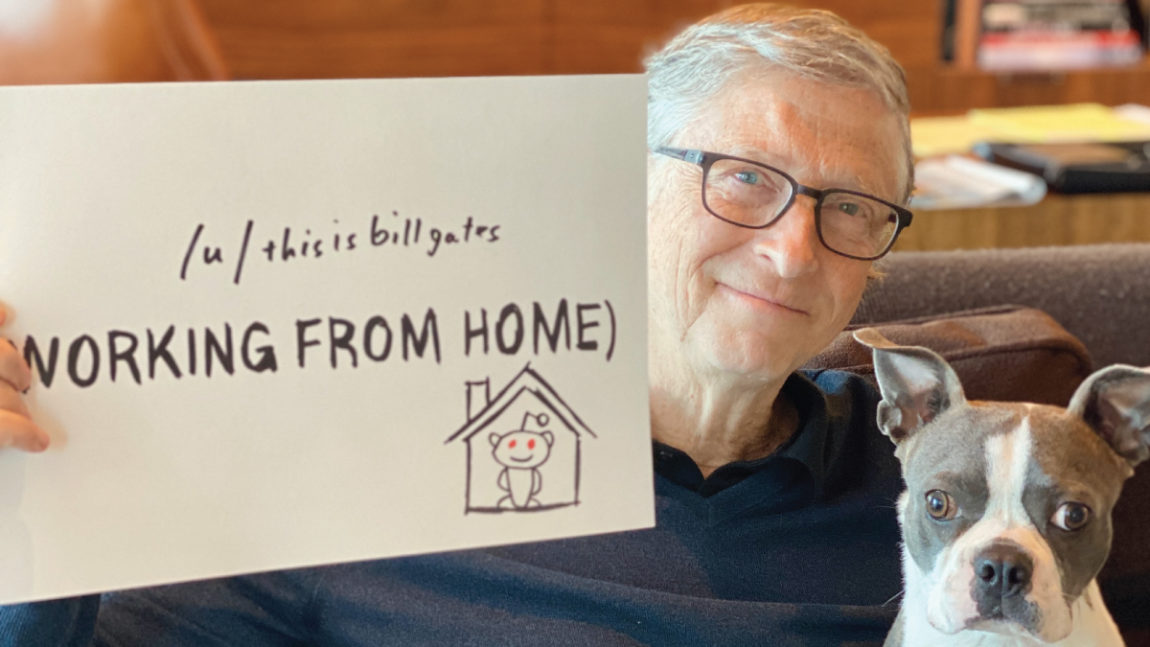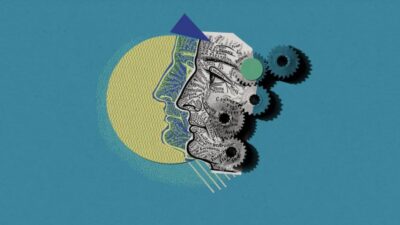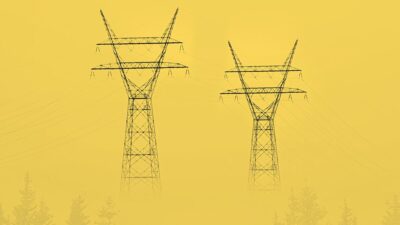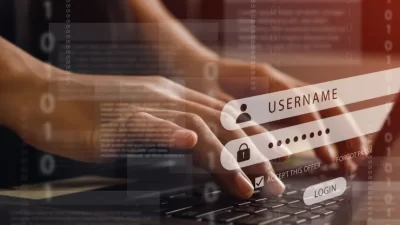My thoughts on what to do now and other topics.
Yesterday I did a Reddit Ask Me Anything session on COVID-19. As usual, Redditors asked a lot of smart questions, and it was a great opportunity to have a fact-based discussion about this pandemic and what we can do to prevent the next one. (And as I mentioned in this exchange, it’s nice to have so many positive interactions in such an uncertain time.)
Below is a transcript of all the questions I could get to (lightly edited for length), along with my answers. I’ll be sharing more about COVID-19 here on the Gates Notes and on my social channels. In the meantime, stay healthy and keep washing your hands!
Redditor’s question: What about the current crisis worries you the most? What gives you the most hope?
My answer: The current phase has a lot of the cases in rich countries. With the right actions including the testing and social distancing (which I call “shut down”) within 2-3 months the rich countries should have avoided high levels of infection. I worry about all the economic damage but even worse will be how this will affect the developing countries who cannot do the social distancing the same way as rich countries and whose hospital capacity is much lower.
—
Can you explain briefly what most Americans can do to help other Americans in this moment of crisis?
A big thing is to go along with the “shut down” approach in your community so that the infection rate drops dramatically to let us go back to normal as soon as possible. Some people like health care workers will be doing heroic work and we need to support them. We do need to stay calm even though this is an unprecedented situation.
—
Is there any chance that the 18 month timeline for development of a vaccine can be shortened, and by how much?
This is a great question. There are over 6 different efforts going on to make a vaccine. Some use a new approach called RNA which is unproven. We will have to build lots of manufacturing for the different approaches knowing that some of them will not work. We will need literally billions of vaccines to protect the world. Vaccines require testing to make sure they are safe and effective. Some vaccines like the flu don’t for the elderly.
The first vaccines we get will go to health care workers and critical workers. This could happen before 18 months if everything goes well but we and Dr. Fauci and others are being careful not to promise this when we are not sure. The work is going at full speed.
—
I’d also like to ask the same thing, but with regards to the timeline for an effective treatment.
A therapeutic could be available well before a vaccine. Ideally this would reduce the number of people who need intensive care including respirators. The Foundation has organized a Therapeutics Accelerator to look at all the most promising ideas and bring all the capabilities of industry into play. So I am hopeful something will come out of this. It could be an anti-viral or antibodies or something else.
One idea that is being explored is using the blood (plasma) from people who are recovered. This may have antibodies to protect people. If it works it would be the fastest way to protect health care workers and patients who have severe disease.
—
As an educator, what is something I can do for my students, especially for my low-income students who don’t have access to technology during this time? I have tried to send reassuring emails (including cat pictures), but I worry about the educational impact, as well as the long-term impact to my students’ well being.
It is a huge problem that schools will likely be shut down for the next few months. I am impressed by the creative approaches that many teachers are coming up with to teach remotely. (If you are a teacher reading this, thank you for the work you’re doing.) But I know that not everyone is set up to teach remotely. There are a lot of good online resources out there, including Khan Academy, CommonLit, Illustrative Mathematics, Zearn, and Scholastic. Comcast and other internet connectivity providers are doing special programs to help with access. Microsoft and others are working on getting machines out but the supply chain is quite constrained. Unfortunately low-income students will be hurt more by the situation than others so we need to help any way we can.
—
What do you think about China’s response to the outbreak? How would you rate their response on a scale 1-10?
After January 23 when they realized how serious it was they did strong social isolation which made a huge difference. Of course that isolation created a lot of difficulties for the people involved but they were able to stop the case spread. Other countries will do it somewhat differently but a combination of testing and social isolation clearly works and that is all we have until we get a vaccine.
—
In your opinion, after this pandemic comes to a close, however long that may be, what should be the first step we as a global community take so that we are better prepared for the next pandemic?
The TED talk I did in 2015 talked about this. We need to have the ability to scale up diagnostics, drugs and vaccines very rapidly. The technologies exist to do this well if the right investments are made. Countries can work together on this. We did create CEPI = Coalition for Epidemic Preparedness Innovation which did some work on vaccines but that needs to be funded at higher level to have the standby manufacturing capacity for the world.
—
Why do you think most world governments weren’t prepared if you and other experts warned of such events such as this?
No one could predict what the chance of a new virus emerging was. However we did know it would happen at some point either with a flu or some other respiratory virus. There was almost no funding. The creation of CEPI which was funded by our foundation, Wellcome, Norway, Japan, Germany, and the UK was a step but tiny compared to what should have happened. We prepare for possible wars and fires and now we have to have preparation for epidemics treated with the same seriousness. The good news is that our biological tools including new ways to make diagnostics, therapeutics and vaccines make it possible to have a strong response system for naturally caused epidemics.
—
I live in Seattle, like you, and it feels like our testing has not increased. Our number of confirmed cases are starting to lag behind other states. What do you think gives? Effective social distancing or lack of testing?
The testing in the US is not organized yet. In the next few weeks I hope the Government fixes this by having a website you can go to to find out about home testing and kiosks. Things are a bit confused on this right now. In Seattle the U of W is providing thousands of tests per day but no one is connected to a national tracking system.
Whenever there is a positive test it should be seen to understand where the disease is and whether we need to strengthen the social distancing. South Korea did a great job on this including digital contact tracing.
—
I read the Imperial College COVID-19 Response Team report as well as this explanation in a historical context. Essentially, it says that by doing nothing, 4 million Americans die. Through the mitigation strategy—i.e. social distancing and “flattening the curve”— it says that 1.1-2 million Americans will die. However, it also says that the suppression strategy, or “shutting everything down for 18 months”—will lead to only a few thousand people dying.
Do you agree with these numbers, and if so, is there any excuse for not immediately issuing a shelter in place order for the entire country?
Fortunately it appears the parameters used in that model were too negative. The experience in China is the most critical data we have. They did their “shut down” and were able to reduce the number of cases. They are testing widely so they see rebounds immediately and so far there have not been a lot. They avoided widespread infection. The Imperial model does not match this experience. Models are only as good as the assumptions put into them. People are working on models that match what we are seeing more closely and they will become a key tool. A group called Institute for Disease Modeling that I fund is one of the groups working with others on this.
—
Covid-19 testing standards seem grossly unfair in favor of the rich and famous. Testing is happening for people like professional sports players, even those without any symptoms at all. I’m not talking about health care workers or people in essential jobs- I’m talking about actors, actresses, sports players and so on. On the flip side, the guidance from Kaiser in WA is that you must have a fever of 101.5 and either serious shortness of breath or a bad cough, and even then testing results take 5 days or more.
How is it that even with something like covid-19 testing, which the government is supposed to manage, the rich and famous are getting special treatment? Is there a big stash of tests that are reserved for “people that matter”? Isn’t it hypocritical for everyone else to be told they need to look out for the common good and avoid demanding too much of the health care system, meanwhile the rich and famous get whatever they want, when they want it?
We need to democratize and scale the testing system by having a CDC website that people go to and enter their situation. Priority situations should get tested within 24 hours. This is very possible since many countries have done it. Health care workers for example should have priority. Elderly people should have priority. We will be able to catch up on the testing demand within a few weeks of getting the system in place. Without the system we don’t know what is missing—swabs, reagents etc..
—
What do you think of the current approach the Netherlands is currently taking to combat this virus? They are not going to a full lockdown but rather try to spread it controllably in order to work towards “herd immunity”.
The only model that is known to work is a serious social distancing effort (“shut down”). If you don’t do this then the disease will spread to a high percentage of the population and your hospitals will be overloaded with cases. So this should be avoided despite the problems caused by the “shut down”. If a country doesn’t control its cases then other countries will prevent anyone going into or coming out of that country. I think the Netherlands will end up doing what other countries are doing.
—
Thoughts on chloroquine/hydroxychloroquine?
There are a lot of therapeutic drugs being examined. This is one of many but it is not proven. If it works we will need to make sure the finite supplies are held for the patients who need it most. We have a study going on to figure this out. We also have a screening effort to look at all the ideas for Therapeutics because the number being proposed is very large and only the most promising should be tried in patients. China was testing some things but now they have so few cases that that testing needs to move to other locations.
—
How is your foundation helping the current pandemic? Are you donating money, producing products for health workers?
Our foundation is working with all the groups who make diagnostics, therapeutics and vaccines to make sure the right efforts are prioritized. We want to make sure all countries get access to these tools. We donated $100M in February for a variety of things and we will be doing more. One priority is to make sure that there is enough manufacturing capacity for therapeutics and vaccines. We have other efforts like our education group working to make sure the online resources for students are as helpful as they can be.
—
Is there anything you can do to assist with ventilator production?
There are a lot of efforts to do this. If we do social distancing (“shut down”) properly then the surge of cases won’t be as overwhelming. Our foundation’s expertise is in diagnostics, therapeutics and vaccines so we are not involved in the ventilator efforts but it could make a contribution to have more especially as the disease gets into developing countries including Africa.
—
Should there be a national shelter in place order? Why or why not?
Most people can shelter in their home but for people who that doesn’t work for there should be a place for them to go. We are working on seeing if we can send test kits to people at home so they don’t have to go out and so the tests get to the people who are the priority. The US still is not organized on testing.
—
What changes are we going to have to make to how businesses operate to maintain our economy while providing social distancing?
The question of which businesses should keep going is tricky. Certainly food supply and the health system. We still need water, electricity and the internet. Supply chains for critical things need to be maintained. Countries are still figuring out what to keep running.
Eventually we will have some digital certificates to show who has recovered or been tested recently or when we have a vaccine who has received it.
—
When will this all end?
To bring it to small numbers globally we need a vaccine. Many rich countries will be able to keep the number of cases small (including the US) if they do the right things but developing countries will find it very difficult to stop the spread so a vaccine is critical. A group called GAVI helps buy vaccines for developing countries and they will play a key role once we have a vaccine being made in volume.
—
How long will this go on?
This will vary a lot by country. China is seeing very few cases now because their testing and “shut down” was very effective. If a country does a good job with testing and “shut down” then within 6-10 weeks they should see very few cases and be able to open back up.
—
Won’t a rebound happen after the shutdown ends?
It depends on how you deal with people coming in from other countries and how strong the testing effort was. So far in China the amount of rebound being seen is very low. They are controlling people coming into the country very tightly. Hong Kong, Taiwan and Singapore have all done a good job on this. If we do it right the rebounds should be fairly small in numbers.
—
What is the projected amount of positive cases in 1 month? 3 months? 6 months?
Any thoughts or theories as to what will happen in China when the lockdown is lifted?
Is it possible that a 2nd wave could come out?
China is not reporting much rebound. The number of cases in South Korea is going in the right direction. If people who test positive isolate themselves then the spread can be very low. The sooner people know they are infected the sooner they can isolate.
—
Can you provide any estimates for how much of the world’s population might become infected?
This will vary a lot by country. Taiwan, Hong Kong and Singapore acted quickly and will have very few cases. Even China will stay at a low level of their population (less than .01%) so far. Thailand is another exemplar. Unfortunately in poorer countries doing social distancing is much harder. People live in close proximity and need to work to get their food so there could be countries where the virus will spread broadly.
—
Given the economic impact of COVID-related social distancing, isolation, and quarantine, is your foundation committed to anything beyond direct medical intervention? For example, increasing funding to food banks, politically supporting bills that provide income/sick leave for workers, etc.?
The Foundation is focused on its area of expertise which is diagnostics, therapeutics and vaccines. There will be lots of opportunity to give to social service organizations including food banks and I am sure people will be generous about this. Once we know who tests positive we can figure out how to support them so they can stay isolated and still get the food and medicine they need.
—
I have friend who is an NHS doctor. Since yesterday he is working without masks as they have run out. Who is hogging all the masks?
I am sorry to hear this. This is an example of why we need the social distancing to minimize the number of cases and why we need the national testing network and database to get running as soon as possible.
—
What about the NY Times report that just came leaking a government document saying this will be 18 months with “multiple waves”?
There are many models to look at what will happen. That article is based on a set of assumptions derived from Influenza and it doesn’t match what has happened in China or even South Korea. So we need to be humble about what we know but it does appear that social distancing with testing can get the cases down to low levels.
—
But when they open back up is not like starting over? The total number of cured vs those who can still be infected is still small.
The goal is to keep the number infected to a small percentage. In China less than .01% of the population was infected because of the measures they took. Most rich countries should be able to achieve a low level of infections. Some developing countries will not be able to do that.
—
Do you believe the news coming out of China though? It’s hard to at this point.
China is doing a lot of testing. South Korea is also doing a good job of testing. Once China got serious in January they have been quite open about their cases so yes the good news is they are seeing very few infections at this point. The US needs to get its testing system organized so we see what is going on.
—
What precautions should I take when delivering things such as groceries to my grandparents to limit my exposure to them?
Hand washing is key. Keeping a distance. Having someone else do it if you have a fever or are coughing.
—
Why are we not on a lockdown yet?
We are going into lockdown but as usual in retrospect we should have done it sooner. The sooner it is done the easier it is to get the cases down to small numbers.
—
How is the economy likely to recover after all of this in your opinion?
Yes eventually. The economic impact of the “shut down” will be large but if it is done well (including the testing piece which I keep mentioning) eventually we can open back up.
—
What do you see as the long-term strategy for fighting this pandemic and do you feel like it will adequately prepare us for the next?
I think that after this is under control that Governments and others will invest heavily in being ready for the next one. This will take global cooperation particularly to help the developing countries who will be hurt the most. A good example is the need to test therapeutics wherever the disease is to help the whole world. The Virus doesn’t respect national boundaries.






